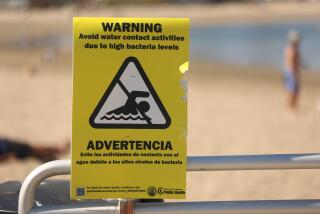Lesson for Inland Swimmers: Ocean Poses a Sea of Troubles
- Share via
Troubled by an unusually high number of ocean drownings this summer, lifeguards in Orange and Los Angeles counties say education -- including efforts to teach young people from inland cities how to contend with treacherous rip currents -- is critical to saving lives.
Los Angeles County sponsors a year-round beach-safety program for children in inland communities. But Orange County relies mostly on a junior lifeguard program, which provides limited benefit to families that have no easy access to the water.
“A lot of times it’s [a matter of] knowing your physical limitations,” said Michelle Feczko of the Drowning Prevention Network of Orange County. “It’s dangerous out there, and people who don’t live near the ocean don’t realize it’s a foreign environment.”
What worries lifeguard agencies is that four of the six Orange County ocean drowning victims this year visited the beach from inland cities: El Monte, Fullerton, Lakewood and Riverside.
Inland residents often arrive later in the day than locals and stay later. With unseasonably warm water tempting some to stay in the surf after it becomes too dark for lifeguards to stay on duty, one result is an unusually high number of drownings and rescues.
At Huntington State Beach, rescues doubled in July from a year ago to more than 1,600. Los Angeles County lifeguards made 4,125 rescues last month, the highest ever for July, said county lifeguard Capt. Garth Canning.
Rip currents play a role in 80% of the rescues, lifeguards said. Rip currents create strong flows away from the beach, often causing swimmers to panic. These currents also can propel swimmers into rocks, piers, pilings and jetties.
Many beachgoers from inland cities are well-aware of the risks. “It’s not like a swimming pool,” said Garbriel Lespron, 18, of Whittier, who was at Huntington State Beach swimming recently with friends Vincent Ramirez, 17, and Paul Ramirez, 15.
“You lose a lot of strength fighting to stay where you are in the water,” Lespron said, recalling a rip current so strong it carried him dozens of yards from where he entered.
But many are not so well-informed. To help prevent drownings, both counties try to educate inland residents.
This year most lifeguard agencies have cut back on education and outreach programs due to budget cuts. But Los Angeles County’s WATER program -- water awareness, training, education and recreation -- remains strong.
It focuses on children who live some distance from the beach. They are picked up by 15-passenger vans in East Los Angeles, South Los Angeles and the San Fernando Valley, said Stacy Smith, a county lifeguard who coordinates the program. Cost is $125 for five days at a camp and financial aid is available, she said.
Lifeguards teach children ages 7 to 17 about ocean skills, marine life, canoeing, kayaking, and beach games. Program locations vary, with most of the sailing instruction done at Marina del Rey and surfing at Manhattan Beach.
“The whole focus is beach safety,” Smith said. “In a way it’s reaching potential victims before they get to the water.”
It’s a joint program between lifeguards and county Beaches and Harbors. Rather than relying on tax revenue, the program has found corporate sponsors for the vans and transportation costs, she said.
“Even with budget cutbacks, we’re able to survive,” she said.
In Orange County, lifeguards do outreach, but a tight budget limits it to brief presentations at local schools, impromptu instruction on the sand and single-day events.
Lifeguards recommend that parents and group leaders visit lifeguard towers to discuss beach conditions. The shifting ocean bottom can create dangerous rip currents at a favorite beach that may not have had them a previous week.
More to Read
Sign up for Essential California
The most important California stories and recommendations in your inbox every morning.
You may occasionally receive promotional content from the Los Angeles Times.













